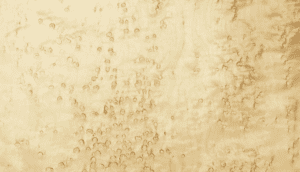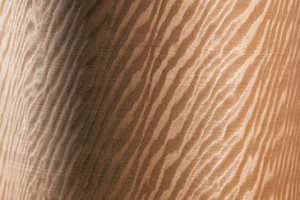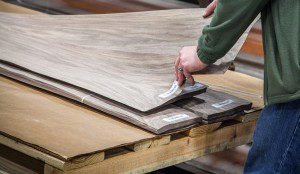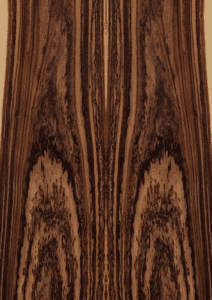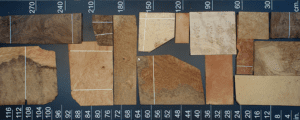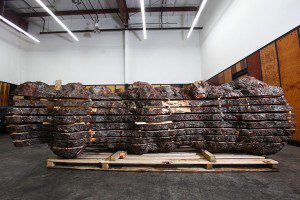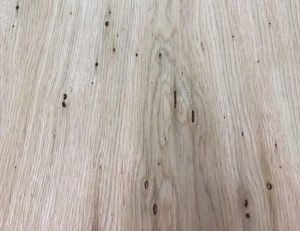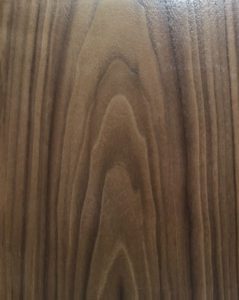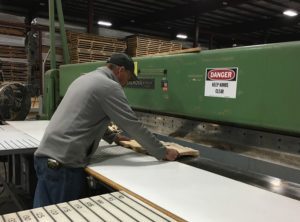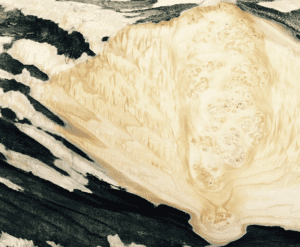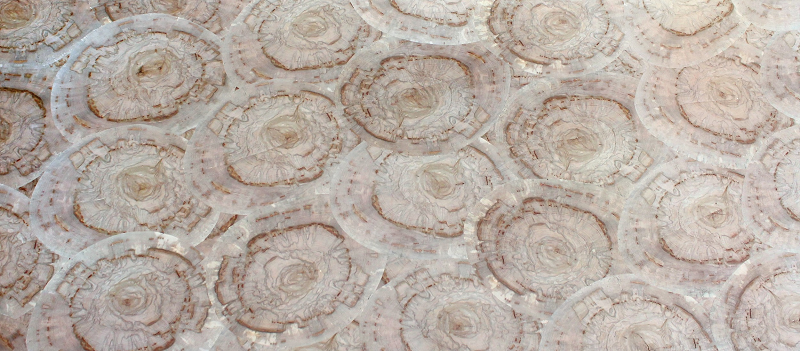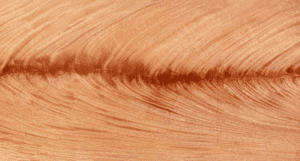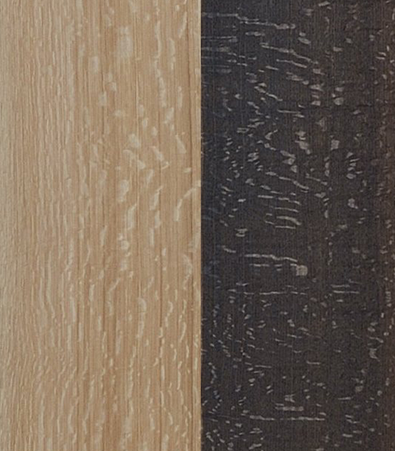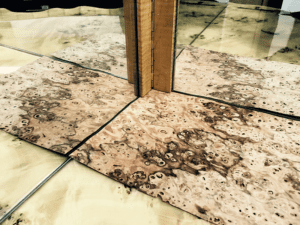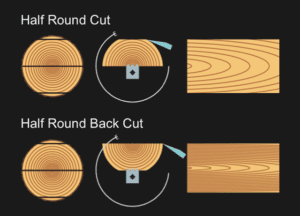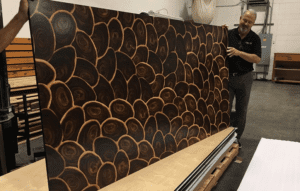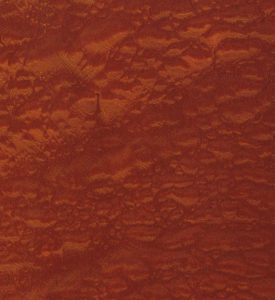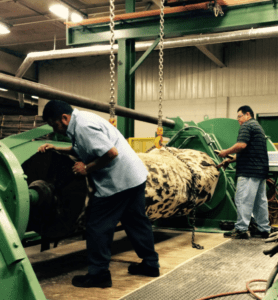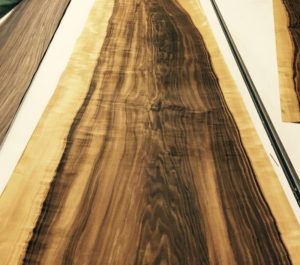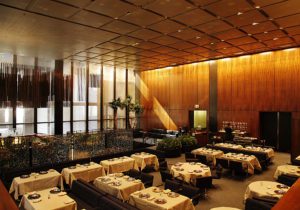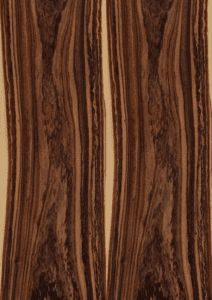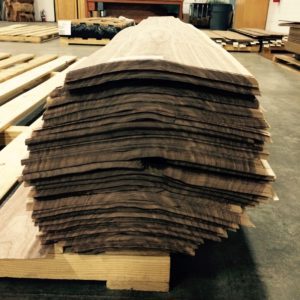A complete Glossary of wood veneer terminology… with pictures!
Air Drying
Earlier the most usual method of drying veneers. These were placed as single or double leaves in so-called stacking carriages and were dried completely without any technical aids or fan. Very time-consuming. Natural drying has been replaced by jet drying.
Air-Dried Lumber
Solid wood which has been air dried without kiln drying.
Architectural Grade
Top quality log and veneer length over 2.65 meters (8.5 feet). Refer to Architectural Woodwork Standards, Premium Grade.
Backing
The lowest grade veneer which is generally only used yet as crossband veneers or for non-visible surfaces. Sold generally by the ton.
Backing Board
The boards which remain after slicing wood. Much appreciated as solid wood because these generally include the standing years and thus are relatively free of tension.
Birdseye
The term given to eye-shaped marking of the veneer, especially in the case of Birdseye Maple.
Block Mottle Figure
An irregular form of figuring which runs over the complete surface of the veneer.
Blue Stain
Blue stains on the surface of the veneer which occur through insufficient water extraction when slicing (too low heating capacity on the pressure bar or when slicing too fast) because water remaining on the surface of the veneer turns blue through oxidation.
Book
The most commonly used term for a bundle of veneer, especially by carpenters. This term comes from the veneer leaves following one after the other like pages in a book.
Book Match
A procedure in the further processing of veneers by which the successive veneer leaves are glued alternately with the front and rear side to retain a mirror-inverted sequence.
Buckle
Corrugation caused in the veneer leaf when drying as a result of different drying runs and irregular annual ring development within the veneer leaf. The veneer has to be flattened again to make the veneer saleable.
Bundle
Cut bundles of veneer generally containing 24 or 32 consecutive leaves in cutting sequence. (pictured: three seperate bundles being sampled from)
Burl
A term for veneers which are produced from the burr or burl formation. Differentiation is generally made between burl or burr growth above ground (Elm, Ash, Oak) and root burl or burr growth which develops below ground in the root (Californian Walnut, Madrone, Vavona, Myrtle). Pictured: various types and sizes of raw burl veneer.
Boul-Log
Term used for a burly trunk, log or veneer cut.
Butt
The bottom end of a log or veneer frequently featuring coarse annual ring development and undesired color variations caused by its rootstock.
Cancer
A disease of European Oak which destroys the structure in the veneer and appears as an open defect. Very difficult to recognize in the bark.
Cathedral Structure
Much sought after structure in crown cut bundles.
Clipping
The clipping of veneers on the veneer cutter whether the veneers are in their initial or in final production.
Cluster
Only partially burled logs. Like this Maple cluster which is made up of both quilted grain and burl figure.
Complete Flitch
Veneers which are not only produced from one log but where all leaves remain in their exact original log sequence.
Compression Wood
The zones given in soft wood through irregular annual ring structure which are particularly hard and, therefore, cause difficulties when slicing the veneer.
Condensate
The tannic acid which is yellow in color and deposits on the surface of the veneer when it is dried too sharply.
Cross Cut
Veneer produced when cutting through the trunk of a tree revealing both the size of the trunk and the log’s growth rings. (Also referred to as Oyster Shell or Butt-Cut)
Cross Grain
Buckling of the veneers given through irregular growth or through logs under high tension. It shows itself also as darker coloring down the annual rings.
Crotch
Crotch veneer figuring sometimes termed “curl” is manufactured from the intersection of the limb or branch with the main trunk. The quality is all the better the more precise and distinct the crotch and feather are.
Curl
see Crotch
Curl Fishbone Figure
Typical figure development especially in beech which is generally considered to be degrading.
Defect
Overgrown branch which leaves a clearly distinct bark pattern. The earlier the tree has got rid of its branch the less visible is this characteristic in the bark.
DIN
The standards valid in Germany for the production of veneer. The standard thicknesses are laid down therein.
Discoloration
Undesirable color variations in the veneer, e.g. green stripes in European Cherry.
Divider
A strip of wood placed between the veneers to increase the strength of a pallet or to ensure the stability of the flitches stacked in log-form. Also separates the different logs from each other.
Door Length
Log and veneer lengths between 2.05 and 2.40 meters (6.6 to 7.5 feet) required by the door industry.
Egg Shape
A structure in the crown cut bundle desired by the piano industry. Required by them for the fronts and lids of their instruments.
Fiddle, Fiddle-Back, Figure
Clearly visible and more or less regular streaks running across the grain in different species of wood (e.g. in Sycamore, Macore, Peartree, Ash). The more regular these streaks are the more valuable the veneer.
Flake
The typical figuring of wood when the pithrays are cut across, i.e. at an angle of 180 degrees when slicing. This is particularly strongly pronounced in Oak. It is generally considered as inferior veneers except from Brown Oak, Silky Oak or Plane for example, where this figuring is in special demand. Pictured below is a Flaky Oak and a Fumed Flaky Oak which shows the high reflectance of flake.
Flares
Irregular veneer marking which generally is not desired.
Flashy Look
Expression for irregularly alternating spiral grain which causes more or less irregular markings in the veneer. Especially found in Black Cherry veneers.
Flat Cut
The first bundles from a log when sliced over the heart. Produces the so-called “cathedral” structure.
Flitch
see Log-end
Four Piece Match
Special method used for burl veneers to produce highly decorative surfaces and patterns. Four veneer leaves in succession are turned twice and folded up once. This design is also called a “book and butt” match. To select the right veneer to focus on we often use a hinged mirror to simulate what the four piece match will look like first.
Fumed Veneer
Fuming is the process of exposing wood to ammonia vapors that darken the wood and emphasize grain patterns. (Below: Fumed Red Gum)
Furniture Grade
Veneer differing in length from 1.00 m to 4.00 m within one log which can be worked up by the living room furniture industry.
Grading
Quality-related grading of veneers and the pricing of the various grades.
Grading Price
Price determination for a veneer log.
Gum
Black spots or patches which can occur in Black Cherry veneer. They are not arranged in a regular pattern but can be positoned quite differently from one veneer leaf to the next.
Hairs
Fine hair streaks which particularly occur in Pear and Maple. They can be distributed over the entire surface of the veneer and are considered to be degrading in quality.
Half Round Cut
Type of conversion on the stay-log machine. Also called eccentric peeling.
Heart
The term used for the core wood area in veneer which is different in color to the remaining part of the veneer leaf.
Heavy Textured
The annual ring structure of fast growing trees which produce the undesirable coarse marking in the veneer.
Horizontal Slicer
A slicing machine on which the counter movements of the log and knife are horizontal.
In Bark, Ingrown Bark
Bark occurring especially in burl or burr logs within the heart wood which has been overgrown.
Kiln
Equipment for artificial drying of solid lumber with the help of computer-control.
Knot
see Defect
Leaf
A single sheet of veneer.
Light Scratch
Very fine knife scratch which disappears from the veneer when the surface is sanded and as a result does not degrade the veneer.
Log
The section of a tree that can be sawn or used for veneer.
Log-End Flitch
Term used for a log or part of a log in log or veneer form.
Log-Run Parcel
A completely converted log parcel which is offered and sold as veneer with all its grades included in it.
Lumber
Already converted solid wood.
Lumber Logs
A grade type for logs that describes sawing quality logs. (Not to be mistaken for veneer quality logs.)
Mesh Belt Jet Veneer Drier
see Jet drier
Mild Texture
Very fine and slow growing wood which produces a beautiful, even marking in the veneer.
Minerals
Dark patches or pockets in wood, especially occurring in the American Oak.
Offcut
see Slab
Open Defect
Faults in veneer which produce holes.
Oyster Shell Veneer
Oyster shell veneer sheets are made up from a log that’s been sliced through the trunk instead of along the trunk as typical veneer.
Panel Length
Log and veneer lengths between 2.65 m and 3.20 m required by the panelling industry. Quality generally not as good as bedroom furniture length.
Parcel
A quantity of veneer prepared for the customer, often sorted into uniform qualities.
Partial Burl
see Cluster
Pepper
The thin black knots in yew veneer which are the typical figuring of yew veneer. The more pepper there is and the more regular this pepper is distributed over the surface the more valuable the veneer.
Pin Knot
Fine, overgrown pin knots which can only be seen with great difficulty on the bark. Appears as a black streak at the end of the log.
Plain Sliced
see Flat Cut
Pommele
Comes from the French word “Pommelé” (Pomme = Apple). The term given to a regular veneer marking which resembles apples. (pictured: Sapeli Pommele)
Press Drier
In this equipment the veneers are pressed between large rotating drums in addition to running through the jet drier to avoid waviness.
Pressure
Slicing fault which occurs when the gap between the knife and the pressure bar is too small or too large to clear the veneer. Different thicknesses are given and to some extent bad cuts, too.
Pressure Bar
The bar opposite the knife. The gap between the knife and pressure bar is slightly narrower than the thickness of the veneer to generate the necessary counterpressure for a smooth cut.
Pressure Wood
see Compression wood
Quartered
Conversion of veneer logs which have been quartered. Produces quarters and half crowns.
Quarters
The bundles from a log which are given after opening the flitch (and, sometimes, cutting out of the heart) where the annual rings are cut radially at an angle of 90 degrees by the knife. Typical stripy structure of the veneer.
Resin Pockets
Resin pockets in softwood which produce holes in the veneer and are thus degrading.
Rift
Quartered veneer flitches converted on the stay-log machine thus resulting in broad quarters being in sequence.
Rift, also Faux Quarter
Quartered flitches which are sliced on the knife in a normal way. It produces half crown and quarters.
Rotary Slicer
Veneer cutting machine on which the log is clamped centrally when brought up to the knife while rotating so that the veneer leaves are peeled off spirally. Used for almost all burl veneers. (pictured: a Quilted Maple burl with birdseye).
Root Burl
see Underground burl
Rough Cut
When slicing veneers rough patches are caused in the surface because of bad clamping of the log, setting the machine wrongly or by too strong fluctuations in texture. The cause can also be that the flitch is not hot enough.
Sap
The outer cell layer of the wood between bark and heartwood. The supply of water and nutrients to the tree is only through the outer row of sap cells. The remaining layers of cells in the sapwood only serve to store water. Color offset in sapwood. The sapwood is cut away in veneers but sometimes it’s kept to create beautiful book match patterns.
Scratch
A notch which runs across the veneer leaf caused by a faulty knife. Typical slicing fault which makes the further use of the veneer questionable. Fine knife scratches are eliminated by grinding the knife.
Sequence
The sequence of veneer leaves within a bundle and the complete log. (pictured: Phillip Johnson’s Four Seasons hotel restaurant is one of the greatest examples of sequenced veneer.)
Shake
Cracks in the lumber which follow the course of the annual rings. Part of trunks with this defect are not suitable for producing veneer or sawn timber.
Short Length
Log and veneer between 0.80 m and 2.00 m in length.
Single Bundles
Bundles of veneer taken out of their regular sequence within the log so that the sequence is no longer given. Generally lower qualities or quarters.
Slab
First side board of the round trunk which is cut off when preparing for slicing, generally used for firing or as waste wood. (pictured: the top piece is considered the “slab”)
Slip Match
A method of further processing veneers by which the consecutive leaves are only glued with the front side.
Slip Verneers
see Turning veneers
Stacked in Log Form
The presentation of veneers stacked in their original log form.
Stain
Color changes in the log when same has been stored too long. Direct radiation from the sun or too dry an atmosphere furthers this development. This is why logs for storage are waxed on the ends or sprinkled with water to avoid this development.
Starter Bundles
The first bundles cut from a log.
Stay-Log
Special veneer cutting machine in which the line of cut sweeps across the growth rings in a circular direction to give eccentric cutting.
Stripy
More or less clearly contrasting color stripes in the veneer which are generally considered as degrading. Known above all in the European Oak.
Sugar
see Hairs
Tan Bark
Water containing tannin acid in Oak logs which causes very dark coloring. Moreover, Oak bark is also not suitable for mulching because of its high tannin acid content.
Tegernsee Custom
A recognized standard work used by the wood industry in Germany in which the general regulations for the sawing and veneer industries are laid down (i.e. quality designations for sawn timber, tolerances regarding veneer thickness and leaves with defects, etc.).
Tension
Differences in density occur in a trunk through different growth zones and growth speeds (weatherside) which can lead to tension in the log. When a tree is felled, cracking as a result of tension can occur making its use as veneer questionable. Problem especially with Beech.
Thick Cut
Veneers which are produced in other thicknesses than those laid down in the DIN Standard. Usual thicknesses are 0.9 mm, 1.2 mm, 1.5 mm, 2.0 mm and 2.5 mm. Larger thicknesses are usually produced as sawn veneers, i.e. cut on the block bandsaw.
To Grade
see To sort
To Manufacture
Clipping and bundling of veneers after drying in preparation for sale. Also cutting out defects and clipping to length.
To Open
see To split
To Sort
Cutting a log to the required length and/or the desired method of slicing.
To Split
The cutting out of the heart of a log when defects or rough patches occur during slicing.
Top End
Top end of a log (trunk or veneers).
Tree Burl
Burl wood in which the burl is developed above ground in the tree. Such burls are Oak, Ash, Poplar, Elm.
True Quartier
The cutting of the log into four quarters. In the case of Oak this gives a higher portion of veneers with fine flakes. However, the yield is generally smaller than when converting in other ways.
Turning Verneers
The presentation of a log which is shown bundle by bundle.
Underground Burl
Burl log where the burl development is in the root and the burl is either completely or partially under the ground. These logs have to be dug out to obtain them, an operation which is generally done by hand in order not to damage high quality burls. Underground burls are Myrtle, Walnut, Maple and Vavona or Redwood Burl.
Vat
The pit used for steaming or cooking logs. Earlier it used to be brickbuilt, today such vats are generally lined with steel or aluminium to make the pit more durable.
Vertical Slicer
Vertical slicer on which the log and knife counter movements are carried out vertically.
Void of Grain
Broad, structureless areas in crown cut bundles between their annual rings if the latter are coarse .
Wavy Grain
Wavy marking of the veneer which is given through such annual rings.
Wrapping
A process to “wrap” three-dimensional areas (profiles, curved edges, etc.) with veneers. To some extent this has replaced the molded edges made of solid wood.
Yellow gum, yellow spot
Yellowish brown patches in American Black Cherry, which are considered to be degrading because they are still visible after surface treatment.
